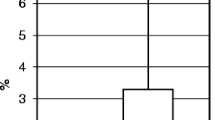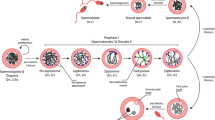Abstract
Purpose
The effect of age on telomere length heterogeneity in men has not been studied previously. Our aims were to determine the relationship between variation in sperm telomere length (STL), men’s age, and semen parameters in spermatozoa from men undergoing in vitro fertilization (IVF) treatment.
Methods
To perform this prospective cross-sectional pilot study, telomere length was estimated in 200 individual spermatozoa from men undergoing IVF treatment at the NYU Fertility Center. A novel single-cell telomere content assay (SCT-pqPCR) measured telomere length in individual spermatozoa.
Results
Telomere length among individual spermatozoa within an ejaculate varies markedly and increases with age. Older men not only have longer STL but also have more variable STL compared to younger men. STL from samples with normal semen parameters was significantly longer than that from samples with abnormal parameters, but STL did not differ between spermatozoa with normal versus abnormal morphology.
Conclusion
The marked increase in STL heterogeneity as men age is consistent with a role for ALT during spermatogenesis. No data have yet reported the effect of age on STL heterogeneity. Based on these results, future studies should expand this modest sample size to search for molecular evidence of ALT in human testes during spermatogenesis.



Similar content being viewed by others
References
Blackburn EH. Telomere states and cell fates. Nature. 2000;408:53–6.
Liu L et al. An essential role for functional telomeres in mouse germ cells during fertilization and early development. Dev Biol. 2002;249:74–84.
Keefe DL et al. Telomere length predicts embryo fragmentation after in vitro fertilization in women—toward a telomere theory of reproductive aging in women. Am J Obst Gynecol. 2005;192:1256–60.
Sahin E et al. Telomere dysfunction induces metabolic and mitochondrial compromise. Nature. 2011;470:359–65.
Schaetzlein S et al. Telomere length is reset during early mammalian embryogenesis. Proc Natl Acad Sci U S A. 2004;101:8034–8.
Kalmbach KH et al. Telomeres and human reproduction. Fertil Steril. 2013;99:23–9.
Krawetz SA. Paternal contribution: new insights and future challenges. Nat Rev Genet. 2005;6:633–42.
Moskovtsev SI et al. Disruption of telomere-telomere interactions associated with DNA damage in human spermatozoa. Syst Biol Reprod Med. 2010;56:407–12.
Kimura M et al. Offspring’s leukocyte telomere length, paternal age, and telomere elongation in sperm. PLoS Genet. 2008;4, e37.
Ioannou D, Griffin DK. Male fertility, chromosome abnormalities, and nuclear organization. Cytogenet Genome Res. 2011;133:269–79.
Lee HW et al. Essential role of mouse telomerase in highly proliferative organs. Nature. 1998;392:569–74.
Reig-Viader R et al. Telomeric repeat-containing RNA (TERRA) and telomerase are components of telomeres during mammalian gametogenesis. Biol Reprod. 2014;90(5):103.
Reig-Viader R et al. Telomere homeostasis is compromised in spermatocytes from patients with idiopathic infertility. Fertil Steril. 2014;102(3):728–38.
Allsopp RC et al. Telomere length predicts replicative capacity of human fibroblasts. Proc Natl Acad Sci U S A. 1992;89:10114–8.
Aston KI et al. Divergence of sperm and leukocyte age-dependent telomere dynamics: implications for male-driven evolution of telomere length in humans. Mol Hum Reprod. 2012;18:517–22.
Baird DM et al. Telomere instability in the male germline. Hum Mol Genet. 2006;15:45–51.
Sartorius GA, Nieschlag E. Paternal age and reproduction. Hum Reprod Update. 2010;16:65–79.
Bryan TM et al. The telomere lengthening mechanism in telomerase-negative immortal human cells does not involve the telomerase RNA subunit. Hum Mol Genet. 1997;6:921–6.
Cesare AJ, Reddel RR. Alternative lengthening of telomeres: models, mechanisms and implications. Nat Rev Genet. 2010;11:319–30.
Dolcetti R, De Rossi A. Telomere/telomerase interplay in virus-driven and virus-independent lymphomagenesis: pathogenic and clinical implications. Med Res Rev. 2012;32:233–53.
Bryan TM et al. Telomere elongation in immortal human cells without detectable telomerase activity. EMBO J. 1995;14:4240–8.
Liu L et al. Telomere lengthening early in development. Nat Cell Biol. 2007;9:1436–41.
Li B, Lustig AJ. A novel mechanism for telomere size control in Saccharomyces cerevisiae. Genes Dev. 1996;10:1310–26.
Bucholc M, Park Y, Lustig AJ. Intrachromatid excision of telomeric DNA as a mechanism for telomere size control in Saccharomyces cerevisiae. Mol Cell Biol. 2001;21:6559–73.
von Zglinicki T, Saretzki G, Docke W, Lotze C. Mild hyperoxia shortens telomeres and inhibits proliferation of fibroblasts: a model for senescence? Exp Cell Res. 1995;220:186–93.
Aitken RJ et al. Oxidative stress and male reproductive health. Asian J Androl. 2014;16:31–8.
Thilagavathi J et al. Analysis of sperm telomere length in men with idiopathic infertility. Arch Gynecol Obstet. 2013;287:803–7.
Ferlin A et al. In young men sperm telomere length is related to sperm number and parental age. Hum Reprod. 2013;28:3370–6.
World Health Organization. WHO laboratory manual for the examination and processing of human semen. 2010; 5th edition
Wang F et al. Robust measurement of telomere length in single cells. Proc Natl Acad Sci U S A. 2013;110:E1906–12.
Nordstokke DW, Zumbo BD. A new nonparametric Levene test for equal variances. Psicológica. 2010;31:401–30.
Turner S, Hartshorne GM. Telomere lengths in human pronuclei, oocytes and spermatozoa. Mol Hum Reprod. 2013;19:510–8.
Blackburn EH, Greider CW, Szostak JW. Telomeres and telomerase: the path from maize, Tetrahymena and yeast to human cancer and aging. Nat Med. 2006;12:1133–8.
Acknowledgements
We thank Dr. Cheongeun Oh (NYU) and Professor Licinio da Silva (UFF) for assistance during the statistical analysis.
Funding was provided by CAPES Foundation, Ministry of Education of Brazil; the NYU Department of Obstetrics and Gynecology; and the Clinical and Translational Sciences Institute at NYU [NIH: #1UL1RR029893].
Ethical approval
This prospective cross-sectional pilot study was approved by the New York University Langone Medical Center Institutional Review Board (IRB).
Informed consent
Each participant provided written informed consent.
Author information
Authors and Affiliations
Corresponding author
Additional information
Capsule The marked increase in STL heterogeneity as men age is consistent with a role for ALT during spermatogenesis.
Rights and permissions
About this article
Cite this article
Antunes, D.M.F., Kalmbach, K.H., Wang, F. et al. A single-cell assay for telomere DNA content shows increasing telomere length heterogeneity, as well as increasing mean telomere length in human spermatozoa with advancing age. J Assist Reprod Genet 32, 1685–1690 (2015). https://doi.org/10.1007/s10815-015-0574-3
Received:
Accepted:
Published:
Issue Date:
DOI: https://doi.org/10.1007/s10815-015-0574-3




